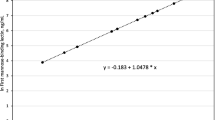Abstract
Serum concentrations of immunoglobulin IgG1, IgG2, IgG3 and IgG4 were determined by radial immunodiffusion in a sample of 414 healthy Greek children, who were admitted to the major Teaching Hospital for Children in Athens for minor surgical operations. Statistical analysis was performed by multiple regression after logarithmic transformation of the immunoglobulin values. There was a statistically significant increase of IgG3 with age, whereas IgG1, IgG2 and IgG4 levels reached a turning point at the age of five years. Older than 5 years male children were found to have marginally higher IgG4 levels than females. Low socioeconomic class was positively and significantly associated (9% increase) with IgG1 levels only among the older age group. History of frequent infections was associated with a 16% increase of IgG1 levels in the younger (less than 5 years) (p = 0.01) and with a 47% increase of IgG4 among the older age group (p = 0.03). Atopic history was associated with a 16% increase of IgG1 in the younger (p = 0.02). The findings of the present study provide an insight on the determinants and the clinical significance of IgG subclass levels among children.
Similar content being viewed by others
References
Levinsky RJ. Introductory remarks. In: Levinsky RJ (ed), IgG subclass deficiencies. International Congress and Symposium Series 143, Royal Society of Medicine Services, London 1989: 1.
Carlsen K-H, Mellbye OJ, Fuglerud P, Johansen B, Solheim AB, Belsnes D, Danielsen A, Henrichson L, Eeg-Olofsson O, Wannag E. Serum immunoglobulin G subclasses and serum immunoglobulin A in healthy Norwegian children and adults. Pediatr Allergy Immunol 1992; 3: 134–139.
Ambrosino DM, Black CM, Plikaytis BD, Reimer CB, Lee MC, Evatt BL, Carlone GM. Immunoglobulin G subclass values in health black and white children. J Pediatr 1991; 119: 875–879.
Jefferis R, & Kumararatne DS. Selective IgG subclass deficiency: Quantification and clinical relevance. Clin Exp Immunol 1990; 81: 357–367.
Preud'Home J-L, Hanson AL. IgG Subclass Deficiency. Immunodeficiency Rev 1990; 2: 129–147.
Pachman L, Lynch P, Silver R, Ozog D, Poznanski A. Primary immunodeficiency disease: An update. Curr Probl Pediatr 1989; 19: 1–64.
Shackelford PG. IgG subclasses: Importance in pediatric practice. Pediatrics in review 1993; 14: 291–296.
Wood RA, Sampson HA. The child with frequent infections. Curr Probl Pediatr 1989; 19: 229–284.
Oxelius V-A. IgG subclass levels in infancy and childhood. Acta Paediatr Scand 1979; 68: 23–27.
Schur PH, Rosen F, Norman ME. Immunoglobulin Subclasses in normal children. Pediatr Res 1979; 13: 181–183.
Heiner DC. IgG4 Immunodeficiency. NER Allergy Proc 1988; 9: 43–50.
WHO. Laboratory investigations in clinical immunology: Methods, pitfalls and clinical indications. Clin Exp Immunol 1988; 74: 494–503.
Hamilton RG. Human IgG subclass measurements in the clinical laboratory. Clin Chem 1987; 10: 1707–1725.
Schur PH. IgG subclasses — a review. Ann Allerg 1987; 58: 89–101.
Morgan G, & Levinksy RJ. Clinical Significance of IgG subclass deficiency. Arch Dis Child 1988; 63: 771–773.
Armitage P, Berry G. Statistical methods in Medical Research. Oxford, UK: Blackwell, 1988.
Snedecor GW, Cochran WG. Statistical methods. Iowa: State University Press, 1967.
Soderstrom T, Soderstrom R, Avanzini A, Brandtzaeg P, Karlsson G, Hanson LA. Immunoglobulin G Subclass Deficiencies. Int Archs Allergy Appl Immun 1987; 82: 476–480.
Rothman KJ. Modern Epidemiology. Boston, MA: Little Brown and Company, 1986.
French MAH, Harrisoh G. Serum IgG subclass concentrations in healthy adults: A study using monoclonal antisera. Clin Exp Immunol 1984; 56: 473–475.
Sondergaard I, Poulsen LK, Osterballe O, Weeke B. Evidence of a common regulation of IgE and IgG subclass antibodies in immunotherapy. Allergy 1992; 47: 467–470.
Author information
Authors and Affiliations
Rights and permissions
About this article
Cite this article
Liatsis, M., Kanariou, M., Petridou, E. et al. Serum immunoglobulin G subclasses in healthy infants and children in Greece. Eur J Epidemiol 13, 151–155 (1997). https://doi.org/10.1023/A:1007389320562
Issue Date:
DOI: https://doi.org/10.1023/A:1007389320562




